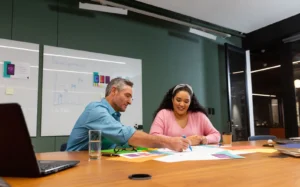

In the digital-first era of real estate, 360-degree tour technology has become an essential asset for real estate seeking to attract and engage clients. By offering 360-degree experiences and creating virtual tours, we empower buyers to explore remotely using a 360-degree virtual tour with clarity and confidence. This blog covers everything real estate professionals need to know about virtual tools and software, from its benefits and tools to creating and marketing experiences.
Table of Contents
Toggle- 360 Virtual Tours for Real Estate Listings
- 3D Virtual Tour Software for Realtors: Interactive Floor Plans and Walkthroughs
- 360° Virtual Tour Creator of Real Estate That Converts
- Immersive Virtual Reality and Experiences for Real Estate Agents
- Features That Make a Great Virtual Home Tour
- Advertising Tactics for Promoting Virtual Tours
- Marketing Your Virtual Tours of Real Estate for Maximum Reach
- Interior and Exterior Applications of Virtual Tours
- Benefits of Virtual Tours to Help Buyers and Sellers
- Property Tours and Listing Advantages with 360° Tech
- Zillow 3D Home Integration and Virtual Embeds
- Realtor Tools for Branding and Lead Generation
- Interior and Exterior Tours with VR Real Estate Integration
- Trends Shaping the Future of VR Real Estate
- Conclusion: Embrace the Real Estate Virtual Tour Future
360 Virtual Tours for Real Estate Listings
Virtual tours bring listings to life by offering a more engaging and detailed presentation of properties. Compared to traditional photos or video tours, virtual tours allow users to move through a space at their own pace and focus on the features that matter to them.
- Build stronger buyer interest and trust
- Increase exposure on platforms like Zillow 3d and MLS
- Provide 24/7 open house access
- Showcase with interior and exterior views
- Reduce unnecessary in-person showings.
By offering listings in a virtual format, real estate can save time while delivering an enhanced experience that better serves remote buyers and busy professionals.
3D Virtual Tour Software for Realtors: Interactive Floor Plans and Walkthroughs
360 Virtual Tour software is the backbone of listings. These platforms enable agents to transform physical spaces into detailed 3D renderings or go through using a 360° camera or mobile device.
Matterport and Zillow 3D Home are the most popular platforms supporting high-quality virtual tour hosting. These platforms allow real estate agents to integrate tours into property buyers, share them on social media, and integrate them into websites for broader exposure. Consider features like mobile responsiveness, analytics tracking, and many options when choosing a platform.
- Zillow 3D helps boost performance through native integration.
- Matterport offers cloud hosting, guided tours, and walking through the property.
- Insta360 supports live virtual showings and fast uploads directly from your device.
- High-quality images in real estate photography.
- Immersive Floor plans
- Room-to-room navigation with virtual house tours
- Hosting options without hidden fees
Agents can create a virtual tour of the Home and upload it to virtual tour platforms or integrate it into real estate sites. This level of customizations stands out and makes navigation intuitive for buyers.
360° Virtual Tour Creator of Real Estate That Converts
Creating a 360 tour requires more than just a camera; it’s about delivering a good interactive experience that reflects the property’s best features.
Steps to create your first virtual tour:
- Use a high-quality 360-degree camera or a compatible smartphone
- Choose software like Matterport or Ricoh Theta for editing and hosting
- Create a 360° panorama view with better floor plans
- Add a virtual tour to highlight unique features
- Publish your 360 virtual tour to your real estate site.
When done right, a professional tour allows viewers to visualize themselves in the space, making them more likely to take the next step.
Immersive Virtual Reality and Experiences for Real Estate Agents
360° reality furthers digital tours by letting users explore properties in full, entertaining environments. With a headset, buyers can virtually step inside homes and walk through them as if they were physically present.
3D reality is particularly effective for:
- New developments or under-construction homes
- International buyers are unable to travel
- Pre-qualified buyers seeking deeper engagement
Including a virtual tour in a listing improves visibility, drives more clicks, and keeps potential buyers engaged longer.
Features That Make a Great Virtual Home Tour
Not all virtual tours are created equal. The most effective ones include:
- Interactive floor plans that allow users to jump between rooms
- 360° panorama images for seamless navigation
- Full coverage with a 360-degree camera capturing 360 photos.
- Hotspots with feature descriptions or embedded media
- Virtual home tours with furniture staging
These features ensure that the buyer experience mirrors a physical tour as closely as possible while enhancing it with data and visuals.
Advertising Tactics for Promoting Virtual Tours
Effectively promoting your virtual tours requires a strategic blend of digital advertising tactics. Real estate professionals can leverage online ads to generate traffic, capture leads, and boost visibility for homes that feature virtual tours. Since many potential buyers begin their home search on digital channels, deploying the right ad tactics ensures your 360 virtual tour stands out.
Targeted advertising through platforms like Facebook and Google Ads allows agents to reach specific demographics, geographic regions, and intent-based audiences. Whether you’re promoting a luxury home with immersive experience or a new development still under construction, aligning the ad creative with your virtual tour content enhances engagement and drives qualified traffic.
- Use retargeting ads to re-engage visitors who interacted with a previous tour.
- Promote your 360 tours with video snippets or highlight reels in sponsored posts.
- A/B test ad formats to determine what drives the most engagement.
Marketing Your Virtual Tours of Real Estate for Maximum Reach
Publishing your 3D tour is just the beginning. To maximize exposure:
- Add virtual tours to your Home on Zillow and MLS
- Share tours on social media platforms and in email campaigns
- Use virtual tour platforms with SEO optimization options
- Create marketing materials featuring your virtual tour link
- Host live walkthroughs using your immersive virtual content
Real estate 3D virtual tours can help agents reach wider audiences, especially buyers who begin their search online. Read here for high-impact real estate digital marketing strategies.
Interior and Exterior Applications of Virtual Tours
Virtual tours aren’t limited to interior shots. Virtual tour technology allows agents to highlight these areas equally well for homes with outdoor features like gardens, pools, or patios.
- Provide full property context
- Use outdoor hotspots to explain amenities
- Display seasonal features or upgrades.
This complete perspective is especially useful for high-value properties and rural home buyers with expansive acreage.
Benefits of Virtual Tours to Help Buyers and Sellers
Virtual tours benefit both sides of the transaction:
- Buyers enjoy a convenient, detailed, and self-guided home-shopping experience
- Sellers attract more attention and may receive offers faster due to increased visibility.
These tours build trust with potential buyers, making them a valuable part of the home-selling process.
Property Tours and Listing Advantages with 360° Tech
360° technology isn’t just revolutionizing single-home listings; it’s transforming property tours. Real estate professionals can now easily offer comprehensive digital walkthroughs of multi-unit buildings, commercial properties, and whole communities. These tours allow investors, relocation buyers, and stakeholders to explore spaces in full context without ever stepping foot on-site.
By compiling multiple lists into a cohesive tour experience, agents can create immersive presentations perfect for virtual open houses or portfolio showcases. Additionally, integrating elements with immersive and interactive experiences, such as logos and agent contact info, reinforces professional credibility and helps build awareness with every viewing.
Zillow 3D Home Integration and Virtual Embeds
Zillow’s 3D Home integration has become a game-changer for real estate professionals looking to stand out on crowded listing platforms. Having a 3D virtual tour directly on a Zillow increases user interaction, boosts time-on-page metrics, and significantly improves the chance of conversion.
These virtual embeds make listings feel more dynamic and comprehensive, especially for out-of-town buyers who rely heavily on digital exploration. With embedded tours, agents can highlight key property features, create smoother buyer journeys, and improve search visibility through better listing performance. It’s a simple yet powerful way to make a listing more compelling and accessible.
Realtor Tools for Branding and Lead Generation
Modern virtual tour software lets agents brand each tour with personalized logos, colors, and CTAs. Real estate home sellers can:
- Capture leads directly within the tour experience
- Build trust and recognition with consistent branding
- These tools turn each virtual tour into a conversion-ready marketing asset.
Interior and Exterior Tours with VR Real Estate Integration
Immersive 3D models for real estate tools are no longer limited to interiors. New platforms support full exterior mapping for:
- Landscaping and garden design
- Outdoor amenities like pools, decks, and patios
- Acreage or unique geographic features
- Providing full 360-degree visuals, giving prospective buyers a holistic understanding of the property.
Trends Shaping the Future of VR Real Estate
As the real estate industry continues to evolve, virtual tours are adapting with advanced features and accessibility improvements:
- Integration with augmented reality (AR)
- AI-generated voice tours and dynamic tagging
- Improved mobile compatibility and fast-loading panoramic files
Looking ahead, 3D tours will become the standard, not the exception. As platforms and cameras improve, creating and sharing tours will be faster, easier, and more affordable for all agents.
Conclusion: Embrace the Real Estate Virtual Tour Future
For real estate looking to remain competitive in a tech-forward industry, investing in 3D virtual software and platforms is a strategic move. With increased demand for good experiences and remote home shopping, virtual tours are no longer optional but essential. From capturing panoramic views to integrating immersive floor plans, a well-crafted virtual tour can transform how you sell real estate.
Marediasoft
We are an agency with over 12 years of experience in web design and development for small businesses. Our custom, responsive web solutions are backed by high ratings from numerous reviews, reflecting our commitment to quality. With a diverse portfolio that includes notable clients like Vodafone, we offer affordable and effective services to help small businesses enhance their online presence.
Categories:

